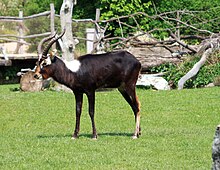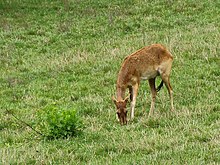Nile lechwe
| Nile lechwe | |
|---|---|
 |
|
 |
|
| male above, female below | |
| Scientific classification | |
| Kingdom: | Animalia |
| Phylum: | Chordata |
| Class: | Mammalia |
| Order: | Artiodactyla |
| Family: | Bovidae |
| Genus: | Kobus |
| Species: | K. megaceros |
| Binomial name | |
|
Kobus megaceros (Fitzinger, 1855) |
|
| Synonyms | |
|
|
The Nile lechwe or Mrs Gray's lechwe (Kobus megaceros) is an endangered species of antelope found in swamps and grasslands in South Sudan and Ethiopia.
Males are an average of 165 cm (65 in) long and 100–105 cm (39–41 in) tall at the shoulders, and weigh between 90 and 120 kg (200 and 260 lb), while females are an average of 135 cm (53 in) long, 80–85 cm (31–33 in) tall at the shoulders, and weigh 60–90 kg (130–200 lb). Nile lechwes live an average of 10 to 11.5 years, and most uncommonly 19 years.
Their coats are shaggy with the hair on the cheeks particularly long in both sexes, and males may have even longer hair on their necks. Nile lechwe exhibit extreme sexual dimorphism. Females are golden-brown with white underbellies and no horns. Juveniles also have a golden-brown coat, but the color changes to dark brown in young males when they reach two to three years of age. Adult males are blackish-brown to russet with white 'hoods' over their shoulders and small white patches over their eyes. The horns of the adult males are 50–87 cm (20–34 in) long, strongly ridged at their bases and are curved at the tips.
Nile lechwe can visually signal and vocalize to communicate with each other. They rear high in the air in front of their opponents and turn their heads to the side while displaying. Females are quite loud, making a toad-like croaking when moving. When fighting, males duck their heads and use their horns to push against each other. If one male is significantly smaller than the other, he may move next to the larger male in a parallel position and push from there, which prevents the larger male from pushing with all his force. Known predators are humans, lions, Nile crocodiles, Cape hunting dogs and leopards. They flee to water if disturbed, but females defend their offspring from smaller predators by direct attack, mainly kicking. Yearling Nile lechwes are often infected by warble flies, which can make them unhealthy and result in high mortality rates.
...
Wikipedia

